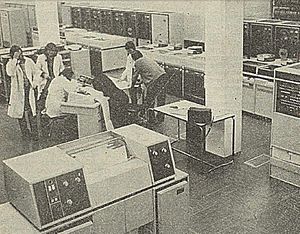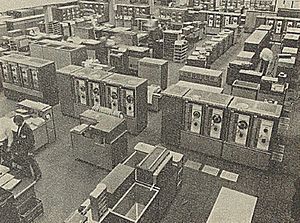International Computers Limited facts for kids

Logo circa 1988
|
|
| Private | |
| Industry | Computer hardware, computer software |
| Fate | Acquired |
| Successor | Fujitsu, Zensar |
| Founded | 1968 |
| Defunct | 2002 |
| Headquarters | , |
| Services | Computer services |
|
Number of employees
|
33,000 (1980), 20,000 (1985) |
International Computers Limited (ICL) was a major British company that made computer hardware, computer software, and offered computer services. It operated from 1968 until 2002. ICL was created by combining several smaller computer companies, including International Computers and Tabulators (ICT) and English Electric Computers.
ICL's most famous products were its mainframe computers, especially the ICL 2900 Series. These were powerful computers used by large organizations. Over time, ICL also sold other types of computers, like personal computers, and equipment for shops, such as point-of-sale systems.
Even though ICL sold computers worldwide, a big part of its business came from contracts with the UK government and other public services. These included the Post Office, tax offices, and the Ministry of Defence. ICL worked closely with the Japanese company Fujitsu from the 1980s. Eventually, Fujitsu bought ICL completely in 1998, and the ICL name was changed to Fujitsu in 2002.
Contents
How ICL Started
International Computers Limited was formed in 1968. The British government, led by Prime Minister Harold Wilson, wanted to create a strong British computer industry. The Minister of Technology, Tony Benn, pushed for ICL to be created. The goal was for ICL to compete with big global computer companies like IBM.
ICL was the result of several computer companies merging. The main parts came from International Computers and Tabulators (ICT) and English Electric Computers. English Electric Computers itself was a merger of other computer divisions like Elliott Automation and Marconi. When ICL was first created, the British government owned 10% of the company and gave it money for research and development.
Early Companies: ICT
International Computers and Tabulators (ICT) was formed from two British companies that made machines using punched cards. These machines processed data stored on cards with holes punched in them.
In 1962, ICT released its first computer that used transistors and core memory, called the ICT 1301. Later, in 1964, ICT bought the computer part of another company called Ferranti. Ferranti had been making scientific computers since the 1950s.
ICT then used a design from Ferranti's Canadian team to create the ICT 1900 series. These computers became very popular and sold thousands of units. The 1900 Series was a strong competitor to IBM's computers in the UK during the 1960s and 1970s. A famous operating system for these machines was called GEORGE3.
One special thing about the 1900 series was that programs could run on any 1900 system without needing to be changed or recompiled. This was a big advantage at the time.
Early Companies: English Electric LEO Marconi
Around the same time, another company called LEO (which started from a food company, J. Lyons and Co.) was trying to build its own computers. LEO sold its computer division to English Electric.
English Electric then decided to use a design from an American company, RCA, to create their System 4 series. These computers were special because they were compatible with IBM's System/360 computers. This made them very appealing to customers in Eastern Europe and the Soviet Union during the Cold War, as it was hard to buy IBM computers there.
The System 4 computers used an operating system called J (for Job). They were often programmed using COBOL and Fortran, which are common programming languages for business and math.
Other Early Computer Companies
- LEO computer Leo 3: This computer had its roots in the food company J. Lyons and Co..
- Elliott 4100: This computer was developed with NCR Corporation. It was transferred to ICL but stopped being sold soon after ICL was formed.
Some other Elliott computers, like the Elliott 900 series, were not included in ICL. These were often used for scientific work or built for military purposes.
Where ICL Operated
ICL's main offices were in Putney, London. The company had many engineering and manufacturing sites across the UK. These included places like Manchester, Belfast, Stevenage, and Kidsgrove.
ICL also had large centers for research, software development, and customer support. A big one was in Bracknell, and another was in Scotland. They even had a software development center in Australia for a few years.
Over time, ICL also gained offices and manufacturing sites in other countries through company purchases, such as in the United States, Sweden, and Finland.
Main Products: 1900 Series and System 4
When ICL was first formed, it had two main computer lines: the 1900 Series from ICT and the System 4 from English Electric Computers.
In the early 1970s, the UK was unique because IBM didn't control more than half of the computer market there. This was partly because ICL was kept alive. The new ICL leaders initially wanted to stop making the 1900 series and focus on System 4. However, they changed their minds, possibly due to pressure from the government.
ICL became very successful, especially by selling computers to the UK public sector, including government offices and nationalized industries. Until the 1970s, the UK government often bought computers from ICL if ICL could meet their needs.
New Generation: 2900 Series
The 2900 Series was a completely new line of computers launched on October 9, 1974. Its design was influenced by advanced research from universities.
These computers ran the VME operating systems. They could also pretend to be older 1900 Series or System 4 computers, which helped customers switch to the new machines. In the early 1980s, ICL started working with Fujitsu to get new computer chip technology.
Some of the models in the 2900 Series included:
- 2950
- 2960
- 2966
- 2970
- 2980
ICL also developed the world's first commercially available massively parallel computer, called the Distributed Array Processor (DAP).
Series 39
The Series 39 followed the 2900 series. It used the same basic design but had much newer hardware technology. It was one of the first mainframe computers to use optical fibres for internal connections. It also allowed multiple CPUs (processors) to work together smoothly.
The Series 39 was so advanced that ICL received the Queen's Award for Technological Achievement for it in 1988.
Operating Systems and Software
ICL developed several operating systems for its computers. The main one for the large 2900 Series machines was called VME. This system was very important for ICL's biggest customers.
ICL also had "superstructure" software, which included tools for managing data and processing transactions.
- IDMS(X): A system for managing large databases.
- TPMS(X): A system for handling many transactions at once, like in banking.
- QuickBuild: Tools to help build applications for the Series 39 mainframes.
ICL computers supported many programming languages:
- PLAN: The assembly language for the 1900 series.
- S3: A special language used to write the VME operating system itself.
- COBOL: A very common language for business applications, known for using plain English sentences.
- Fortran: A language mainly used for mathematical and scientific applications.
- Pascal: Another programming language.
- C: This language became available later, needed to run modern database products like Oracle.
Smaller Computers: 2903 and ME29
The 2903 range was quickly developed to create a smaller computer for businesses, replacing an older model. It was designed to work in a normal office environment, without needing special underfloor cables. This was quite new for computers of its size.
The 2903 used special software to act like the older 1900 series computers, so existing programs could run on it without changes. It also had a new feature called Direct Data Entry, which allowed people to type data directly into the computer using special screens.
The 2903 computers were a huge success, selling about 3,000 systems, which was ten times more than ICL expected!
Later, in 1980, the ME29 system replaced the smaller 290x computers. It used an operating system called TME (Transaction Machine Environment).
Departmental Systems
ICL also sold computers for specific departments within organizations, under the brand name DRS (Distributed Resource System). These included IBM-compatible PCs and larger Unix servers. In 1994, the DRS range was replaced by new server lines called SuperServer and TeamServer.
ICL Subsidiaries
Dataskil
Dataskil Ltd was a software company that belonged to ICL. It developed commercial programs and utility software for ICL computers. Dataskil also provided experts to help with ICL projects.
BARIC Computing Services Ltd
BARIC was a company formed by ICL and Barclays Bank. It offered computer services to other organizations. In the early days of computers, many companies didn't buy their own machines. Instead, they paid service companies like BARIC to do their computer work.
India: ICIM
ICL had a presence in India through International Computers Indian Manufacture Ltd (ICIM). This company manufactured some ICL equipment. Later, ICIM became a joint company with Fujitsu and focused on software development. It was eventually renamed Zensar Technologies.
Defence: DESC
DESC Ltd was an ICL company that focused on defense systems. It was briefly separated from ICL when Fujitsu took over, but later rejoined the main company.
Banking: iBANK Systems
iBANK Systems was a joint project to develop a banking system. It worked with banks in various countries, including Russia, Bulgaria, and Jamaica.
ICL's Company History
ICL went through several changes and takeovers during its history.
Singer Business Machines
In 1976, ICL bought the international parts of Singer Business Machines. This acquisition helped ICL expand its sales outside the UK and enter new markets like retail and manufacturing. ICL developed Singer's System Ten computer into the System 25, which became important for its retail systems business.
Financial Challenges in 1981
ICL faced financial difficulties in 1981. It was struggling to compete with American and Japanese companies. The government helped ICL with loan guarantees, and ICL started a technology agreement with Fujitsu.
STC Takes Over
In 1984, Standard Telephones and Cables (STC) bought ICL. The idea was that computers and telecommunications would become more connected. ICL soon became a very profitable part of STC.
Other Acquisitions
ICL continued to grow by buying other companies:
- Datachecker: In 1988, STC bought Datachecker Systems, a US company specializing in retail systems. This greatly increased ICL's presence in the US.
- Regnecentralen: In 1989, ICL acquired this Danish company, known for its communication equipment.
- Computer Consoles Inc (CCI): Also in 1989, STC bought CCI, which supplied some of ICL's computer ranges.
- Nokia Data: In 1991, ICL acquired Nokia Data from the Finnish Nokia Group. This brought PC manufacturing capabilities and a strong presence in Nordic countries.
Fujitsu's Growing Role
ICL's relationship with Fujitsu began in 1981 when ICL needed cheaper technology for its computers. Fujitsu's involvement with ICL grew steadily. In 1990, Fujitsu bought 80% of ICL. By 1998, Fujitsu owned ICL completely, and the ICL brand was eventually phased out in 2002.
Fujitsu Siemens Computers
In 1999, Fujitsu Siemens Computers was formed as a joint company between Fujitsu and Siemens. This new company took over most of ICL's computer hardware business. Fujitsu Siemens later became part of Fujitsu in 2009.
ICL Trademark Today
In 2014, a British company called International Computer Logistics, which specializes in IT repair, gained the rights to the ICL brand name.
ICL Fellowship
The ICL Fellowship was created in 1990 to recognize ICL engineers who made important achievements in computing. These Fellows were the top technology experts at ICL and advised the company's leaders.
See Also
- Odra (computer): Polish computers that used ICL software.




